Robert Westerfield, Extension Horticulturist, University of Georgia
Kris Braman, Extension Entomologist, University of Georgia
Elizabeth Little, Extension Plant Pathologist, University of Georgia
Frank Hale, Extension Entomologist, University of Tennessee
Ayanava Majumdar, Extension Specialist, Auburn University
A professionally printed version of this publication may be purchased from the 海角官方首页 Extension Publications marketplace store. Delivery will be 7-14 business days from receipt of order.
Common Insect Pests
Diamondback moth (Plutella xylostella)
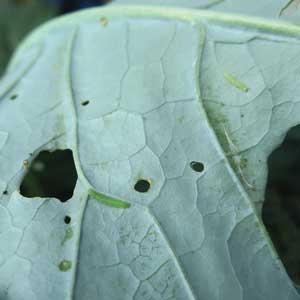
Image credit: F. Hale, University of Tennessee
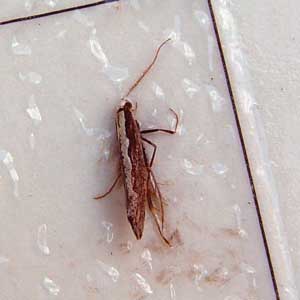
Image credit: F. Hale, University of Tennessee
- Symptoms: Small to medium holes, primarily in leaves and buds.
- Affects: Cruciferous vegetables.
- Management: Remove cruciferous weeds, conserve natural enemies, use insecticides as needed.
Imported cabbageworm (Pieris rapae)
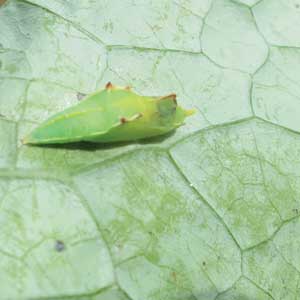
Image credit: F. Hale, University of Tennessee

Image credit: F. Hale, University of Tennessee
- Symptoms: Plants reduced to stems and leaf veins.
- Affects: Cruciferous vegetables.
- Management: Remove cruciferous weeds, conserve natural enemies, use insecticides as needed.
Cross-striped cabbageworm (Evergestis rimosalis)

Image credit: Clemson University, Bugwood.org

Image credit: F. Hale, University of Tennessee
- Symptoms: Small holes in leaves and buds. Large holes in leaves can reduce the plant to stems and leaf veins.
- Affects: Cruciferous vegetables.
- Management: Conserve natural enemies, use insecticides as needed.
Pickleworm (Diaphania nitidalis)
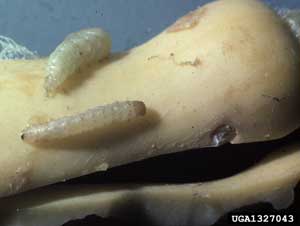
Image credit: A. N. Sparks, Jr., University of Georgia, Bugwood.org
- Symptoms: Burrow in blossoms, fruit and vines, destroying blooms and fruit.
- Affects: Cucurbits.
- Management: Plant early, use screens or row covers, use insecticides from early bloom through harvest.
Corn earworm (Helicoverpa zea)

Image credit: F. Hale, University of Tennessee
- Symptoms: Burrows into corn kernels and fruits.
- Affects: Most vegetables.
- Management: Apply mineral oil, set baits, use insecticides every two-six days.
Squash vine borer (Melittia cucurbitae)
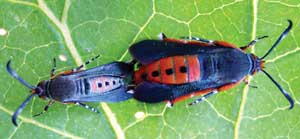
Image credit: A. Wyndham, University of Tennessee
- Symptoms: Wilted leaves and damaged vines.
- Affects: Squashes and some pumpkins.
- Management: Provide a chemical or physical barrier during egg-laying. Plant early, remove dying vines, kill larvae when feasible.
Hornworms (Manduca spp.)
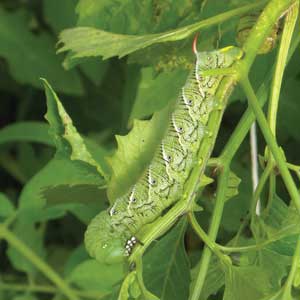
Image credit: S.K. Braman, University of Georgia
- Symptoms: Defoliation of entire plant. Damage to blossoms and fruits.
- Affects: Tomato, eggplant, potato.
- Management: Remove weedy hosts. Monitor for larvae; they may be difficult to find. Frass is the first sign of infestation.
Spotted cucumber beetles (Diabrotica undecimpunctata)
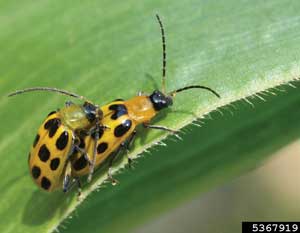
Image credit: R. Ottens, University of Georgia, Bugwood.org
- Symptoms: Small holes in leaves, flowers and fruit; can transmit bacterial wilt disease.
- Affects: Cucurbits and others.
- Management: Use row covers, farmscaping, mulches, resistant varieties and/or insecticides.
Flea beetles (various species)
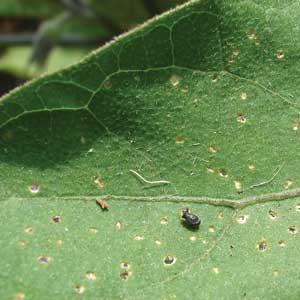
Image credit: F. Hale, University of Tennessee
- Symptoms: Small holes in leaves, especially on young plants.
- Affects: A broad range of fruits and vegetables.
- Management: Use insecticides to protect small seedlings.
Colorado potato beetle (Leptinotarsa decemlineata)
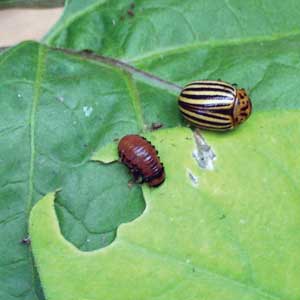
Image credit: S.K. Braman, University of Georgia
- Symptoms: Defoliation of plant.
- Affects: Potato, tomato, eggplant.
- Management: Rotate crops, conserve natural enemies, use resistant varieties, use foliar insecticides.
Mexican and squash beetles (Epilachna varivestis and Epilachna borealis)
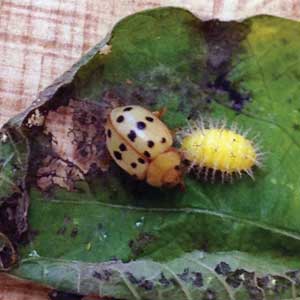
Image credit: S.K. Braman, University of Georgia
- Symptoms: Lace-like, skeletonized leaves. Damaged fruit.
- Affects: Legumes, cucurbits.
- Management: Use insecticides, trap crops or parasitoids.
Aphids and whiteflies
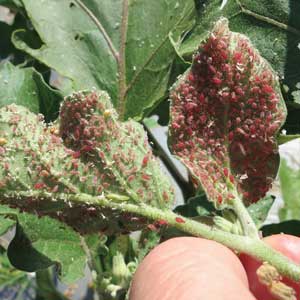 Aphids.
Aphids. Image credit: F. Hale, University of Tennessee
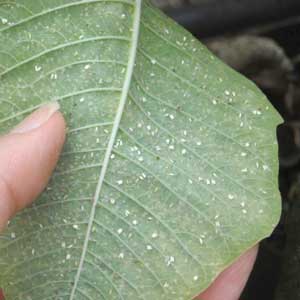 Whiteflies.
Whiteflies. Image credit: F. Hale, University of Tennessee
- Symptoms: Honeydew or sooty mold on leaves. Leaves wilt and die.
- Affects: Many vegetables.
- Management: Early detection important; use insecticides as necessary, conserve beneficials.
Thrips (Frankliniella fusca)
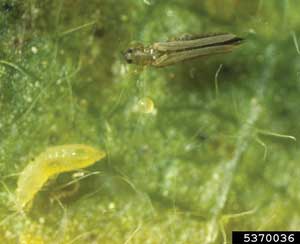
Image credit: J.T. Reed, Mississippi State University, Bugwood.org
- Symptoms: Stunted growth, dropped flowers, silvery scarring; plant may be diseased.
- Affects: Many vegetables.
- Management: Use insecticides and provide sanitation.
Squash and leaf-footed bugs (Anasa tristis and Leptoglossus spp.)
 Squash bug.
Squash bug. Image credit: S.K. Braman, University of Georgia
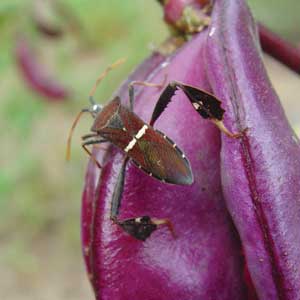 Leaf-footed bug.
Leaf-footed bug. Image credit: F. Hale, University of Tennessee
- Symptoms: Leaves wilt, yellow or blacken, and die. Dropped fruit.
- Affects: Cucurbits and others.
- Management: Plant later. Use clean cultivation and insecticides that target nymphs.
Stink and kudzu bugs (various species)
 Stink bugs.
Stink bugs. Image credit: F. Hale, University of Tennessee
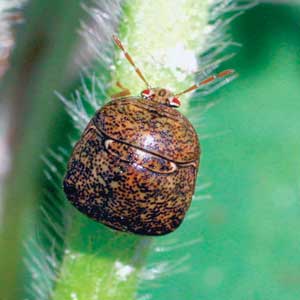 Kudzu bug.
Kudzu bug. Image credit: R. Ottens, University of Georgia, Bugwood.org
- Symptoms: Deformed fruit and blossoms; damage on stems and leaves.
- Affects: Various vegetables.
- Management: Apply foliar insecticides. Remove adults and egg masses by hand.
Common Cultural Problems
Animal browsing
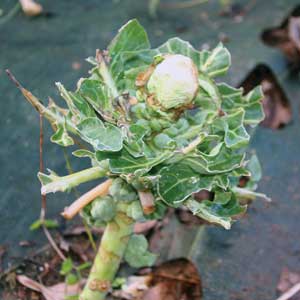
Image credit: R. Westerfield, University of Georgia
- Symptoms: Plants are completely removed or branches and leaves appear cut off.
- Affects: All vegetables.
- Management: Exclude animals with fencing. Repellents may work but are temporary.
Potassium deficiency
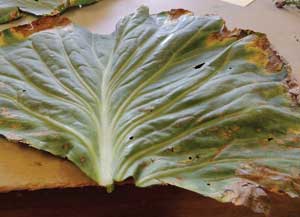
Image credit: R. Westerfield, University of Georgia
- Symptoms: Chlorosis or yellowing on margins of leaves.
- Affects: All vegetables.
- Management: Soil test, adjust pH and properly irrigate.
Sunscald
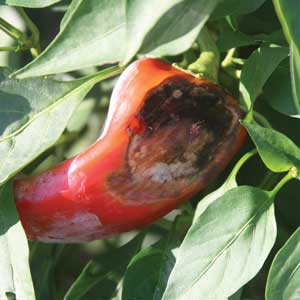
Image credit: R. Westerfield, University of Georgia
- Symptoms: Fruit appears to be brown, wrinkled and sunken.
- Affects: Tomatoes, peppers, eggplants, cucumbers and other vegetables.
- Management: Lightly shade affected plants from afternoon sun until canopy is better developed.
Blossom-end rot
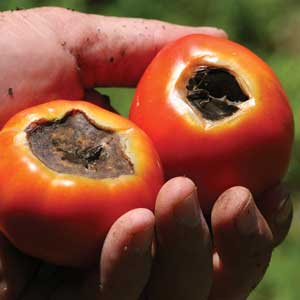
Image credit: R. Westerfield, University of Georgia
- Symptoms: Round, black, water-soaked spot develops on the bottom end of the fruit.
- Affects: Tomatoes, peppers and certain cucurbits.
- Management: Maintain calcium levels. Provide sufficient and consistent irrigation.
Cat-facing
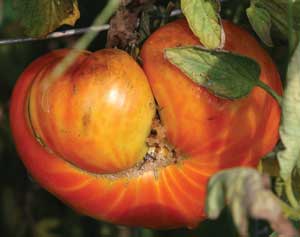
Image credit: R. Westerfield, University of Georgia
- Symptoms: Malformed fruit with greenish bands around it.
- Affects: Primarily tomatoes.
- Management: Avoid planting when soil temperatures aren't warm enough. Provide consistent irrigation and well-drained soil.
Blotchy ripening

Image credit: R. Westerfield, University of Georgia
- Symptoms: Yellow blotches on the outside of the tomato skin. Tissue inside may contain heavy amounts of white core material.
- Affects: Primarily tomatoes.
- Management: Maintain nutrition, proper irrigation and avoid planting in cool soils.
Nitrogen deficiency
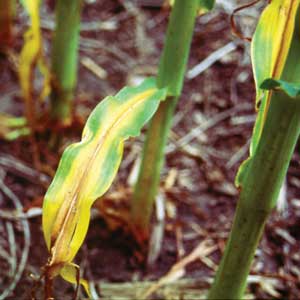
Image credit: South Dakota State University - Plant Science Dept.
- Symptoms: Yellowing in the lower, more mature leaves first with plants growing slowly and stunted.
- Affects: All vegetables.
- Management: Soil test and supply adequate nitrogen.
Cold damage
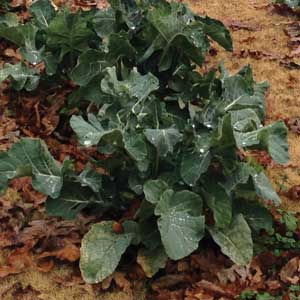
Image credit: R. Westerfield, University of Georgia
- Symptoms: Leaves appear burned and may defoliate.
- Affects: All vegetables.
- Management: Protect tender crops with cardboard boxes; mulch or use row covers when temperatures drop severely.
Phosphorus deficiency
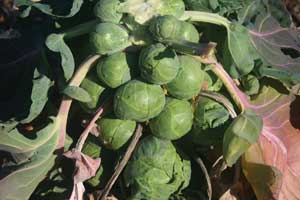
Image credit: R. Westerfield, University of Georgia
- Symptoms: Leaves display purple or bright green hue.
- Affects: All vegetables.
- Management: Soil test for phosphorus and pH levels, especially in cool temperatures.
Drought stress

Image credit: R. Westerfield, University of Georgia
- Symptoms: Uppermost leaves appear brown at tips. Plants droop or wilt.
- Affects: All vegetables.
- Management: Provide sufficient irrigation at root zone.
Overwatering
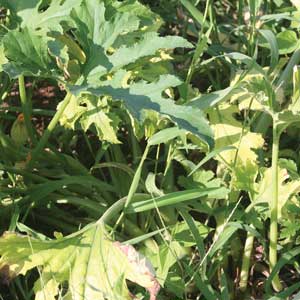
Image credit: R. Westerfield, University of Georgia
- Symptoms: Leaves appear yellow and plant health declines.
- Affects: All vegetables.
- Management: Avoid overwatering; grow plants in well-drained soils.
Herbicide damage
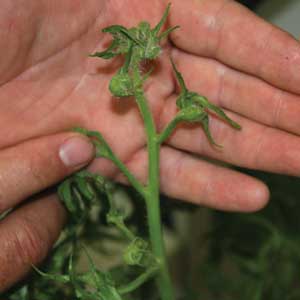
Image credit: R. Westerfield, University of Georgia
- Symptoms: Leaves of affected plants are normally twisted, discolored or distorted.
- Affects: All vegetables.
- Management: Use extreme care when applying herbicides near vegetable gardens.
Leaf roll
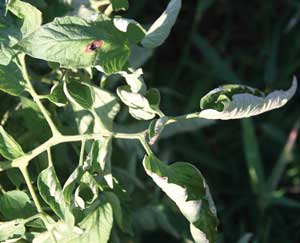
Image credit: R. Westerfield, University of Georgia
- Symptoms: Leaves curl up and appear to be drought-stressed.
- Affects: Primarily tomatoes, but other crops can also be affected.
- Management: Avoid early planting and cool temperatures.
Fruit cracking
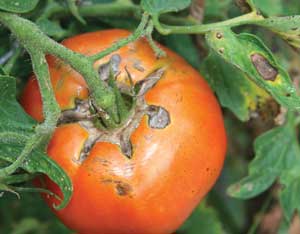
Image credit: R. Westerfield, University of Georgia
- Symptoms: Circular or radial cracks appear on the stem end of ripening fruit.
- Affects: Primarily tomatoes.
- Management: Maintain even soil moisture.
Poor pollination
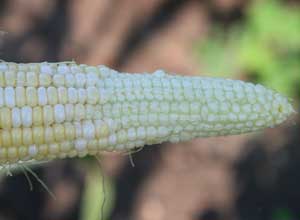
Image credit: R. Westerfield, University of Georgia
- Symptoms: Misshapen fruit or total lack of fruit set.
- Affects: All vegetables.
- Management: Do not apply insecticides early in morning. Plant colorful flowers near the garden to attract more pollinating insects.
Common Diseases
Early blight (Alternaria solani)
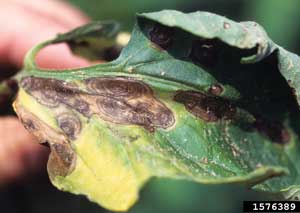
Image credit: G. Holmes, CPSU, Bugwood.org
- Symptoms: Brown lesions on leaves, stems and fruit. Increases during warm, wet weather.
- Affects: Tomatoes and potatoes.
- Management: Rotate crops, use mulch, stake or trellis plants, apply fungicides, remove infected plant material.
Late blight (Phytophthora infestans)

Image credit: E. Little, University of Georgia
- Symptoms: Blighting of leaves, stems and fruit. Plants may die during cool, wet weather.
- Affects: Tomatoes and potatoes.
- Management: Remove infected material, use clean transplants, use resistant varieties, apply fungicides.
Fusarium wilt (Fusarium oxysporum f. sp. lycopersici)
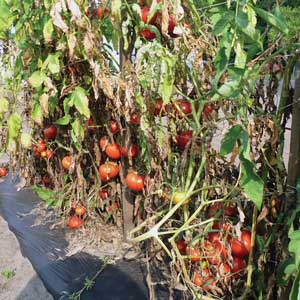
Image credit: E. Little, University of Georgia
- Symptoms: Plants yellow, wilt and die.
- Affects: Primarily affects tomatoes.
- Management: Have long crop rotations, increase organic matter, use resistant varieties.
Cucurbit powdery mildew (Podosphaera xanthii)
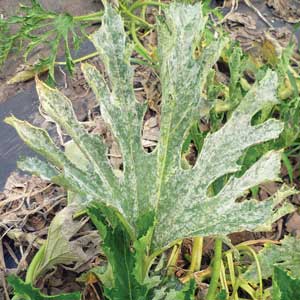
Image credit: E. Little, University of Georgia
- Symptoms: White fungal growth on leaves. Leaves turn yellow and brown.
- Affects: Most cucurbits.
- Management: Plant early in open, sunny areas. Use resistant varieties, apply fungicides.
Cucurbit downy mildew (Pseudoperonospora cubensis)

Image credit: E. Little, University of Georgia
- Symptoms: Yellow to brown spots on leaves; leaves die.
- Affects: Squash, melons, cucumbers.
- Management: Plant early, plant in open, sunny areas. Avoid overhead irrigation, apply fungicides.
Leaf spots on cucurbits (Alternaria, Alternaria cucumerina; Anthracnose, Colletotrichum orbiculare)
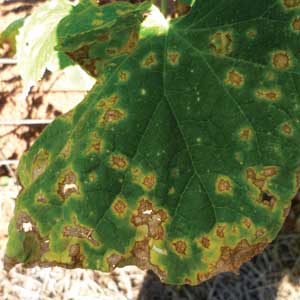 Antracnose.
Antracnose. Image credit: E. Little, University of Georgia
- Symptoms: Brown spots on leaves. Leaves may die.
- Affects melons and cucumbers.
- Management: Rotate crops, plant in open, sunny areas. Grow on trellis, apply fungicides.
Yellow vine disease (Serratia marcescens [bacterium])
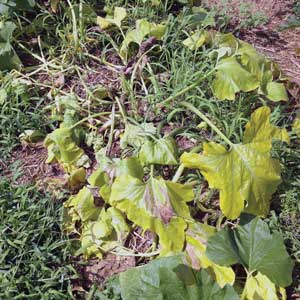
Image credit: E. Little, University of Georgia
- Symptoms: Plants yellow, wilt and collapse. (Spread by squash bugs.)
- Affects: Squash and melons.
- Management: Plant early, manage squash bugs.
Cucurbit viruses
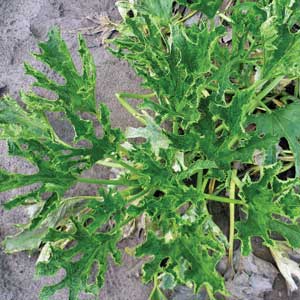
Image credit: E. Little, University of Georgia
- Symptoms: Mottled, distorted and stunted leaves and plants. Common in late summer.
- Affects: Squash, melons, cucumbers.
- Management: Use resistant varieties, plant early, remove infected plants quickly.
Pepper anthracnose (Colletotrichum spp.)
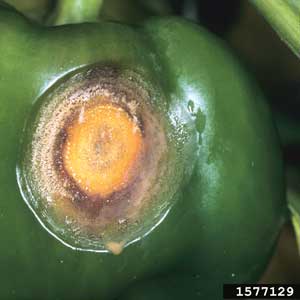
Image credit: G. Holmes, CPSU, Bugwood.org
- Symptoms: Sunken lesions on fruit.
- Affects: Peppers.
- Management: Use disease-free seed and transplants, rotate crops, remove infected fruit, plant in open, sunny areas. Avoid overhead irrigation.
White leaf spot (Pseudocercosporella capsellae)
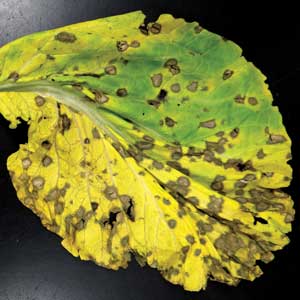
Image credit: E. Little, University of Georgia
- Symptoms: Spots on leaves. Leaves may die.
- Affects: Turnips and mustards.
- Management: Rotate crops, plant in open, well-drained areas. Avoid overhead irrigation, apply fungicides.
Black rot (Xanthomonas campestris pv. campestris [bacterium])
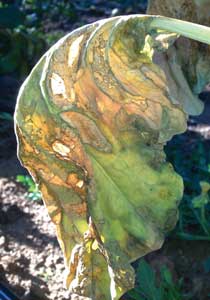
Image credit: E. Little, University of Georgia
- Symptoms: V-shaped lesions on leaf edges. Plants may die.
- Affects: Brassica crops.
- Management: Purchase clean seeds and transplants, rotate crops, avoid overhead irrigation, apply copper.
White mold (Sclerotinia spp.)
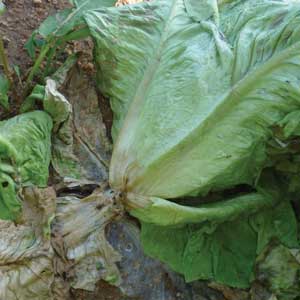
Image credit: E. Little, University of Georgia
- Symptoms: Rot of stems, fruits and flowers. White fungal growth often present.
- Affects: Many vegetables.
- Management: Destroy infected plants, rotate crops, avoid wet soils, increase microbial activity in soil.
Southern blight (Sclerotium rolfsii)
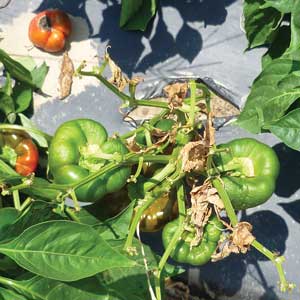
Image credit: E. Little, University of Georgia
- Symptoms: Plants wilt and die. Brown lesions form at soil line.
- Affects: Many vegetables.
- Management: Destroy dead plants, rotate crops, manage soil moisture, increase soil microbial diversity.
Damping off (Rhizoctonia solani, Pythium spp.)

Image credit: G. Holmes, CPSU, Bugwood.org
- Symptoms: Death of seeds and seedlings.
- Affects: Many vegetables.
- Management: Avoid cold, wet soils. Use sterile soil, improve soil microbial diversity, use treated seed.
Root-knot nematodes (Meloidogyne incognita)

Image credit: E. Little, University of Georgia
- Symptoms: Stunting, poor growth, galls on roots.
- Affects: Most vegetables.
- Management: Rotate to non-host cover crops, increase soil microbial diversity, use resistant varieties.
Management Tips
- Check plants frequently and early in the season to detect pests and problems while they are still at a manageable level. Look for signs of discoloration or irregular growth.
- A magnifying hand lens can be a helpful tool.
- Avoid unnecessary pesticide applications to conserve pollinators and other beneficials.
- Use selective pesticides when possible to protect non-target species.
- Get a soil test every two years to avoid nutritional and pH issues.
- Use drip irrigation and keep water off stems and leaves.
- Choose an open, sunny site for garden.
- Improve soil with organic matter to help keep plants healthy.
- Avoid growing the same crop in the same spot (rotate crops).
- Be cautious about mulch. Grass clippings may contain herbicides.
- Remove and destroy diseased plants or plant parts, especially at the end of the season.
Useful terms
- Brassica:
- Vegetables such as cabbage, cauliflower, broccoli and Brussels sprouts.
- Benneficials/ natural enemies:
- Insects, spiders or mites that are predators or parasitoids feeding on insect pests.
- Crop rotation:
- The practice of growing different crops in succession on the same land.
- Cruciferous weeds:
- Members of the mustard family, such as shepherd's purse and hairy bittercress.
- Cucurbit:
- The gourd family containing squash, pumpkin, watermelon, cucumbers and many others.
- Defoliation:
- Loss of leaves.
- Farmscaping:
- Using the whole-farm, ecological approach (hedgerows, insectary plants, cover crops and water reservoirs) for pest management.
- Foliar insecticide:
- Insecticide sprayed directly on the plant's leaf.
- Fungicide:
- A chemical that inhibits the growth of fungi.
- Legumes:
- Beans, lentils, peas, soybeans, etc.
- Nymph:
- An immature form of an insect, like a stink bug or squash bug.
- Parasitoid:
- An organism or insect that lives in or on the body of its host and eventually kills the host.
- Resistant varieties:
- Plant varieties that are less attractive to, tolerant or have negative effects on pests.
- Terminal bud:
- Bud at the tip of a stem.
- Trap crop:
- A crop planted to attract insect pests from another crop, especially one in which the pests fail to survive or reproduce when treated.
This publication was developed collaboratively by university specialists in Georgia, Alabama and Tennessee.
Status and Revision History
Published on Aug 19, 2014
Published with Full Review on Jul 28, 2022